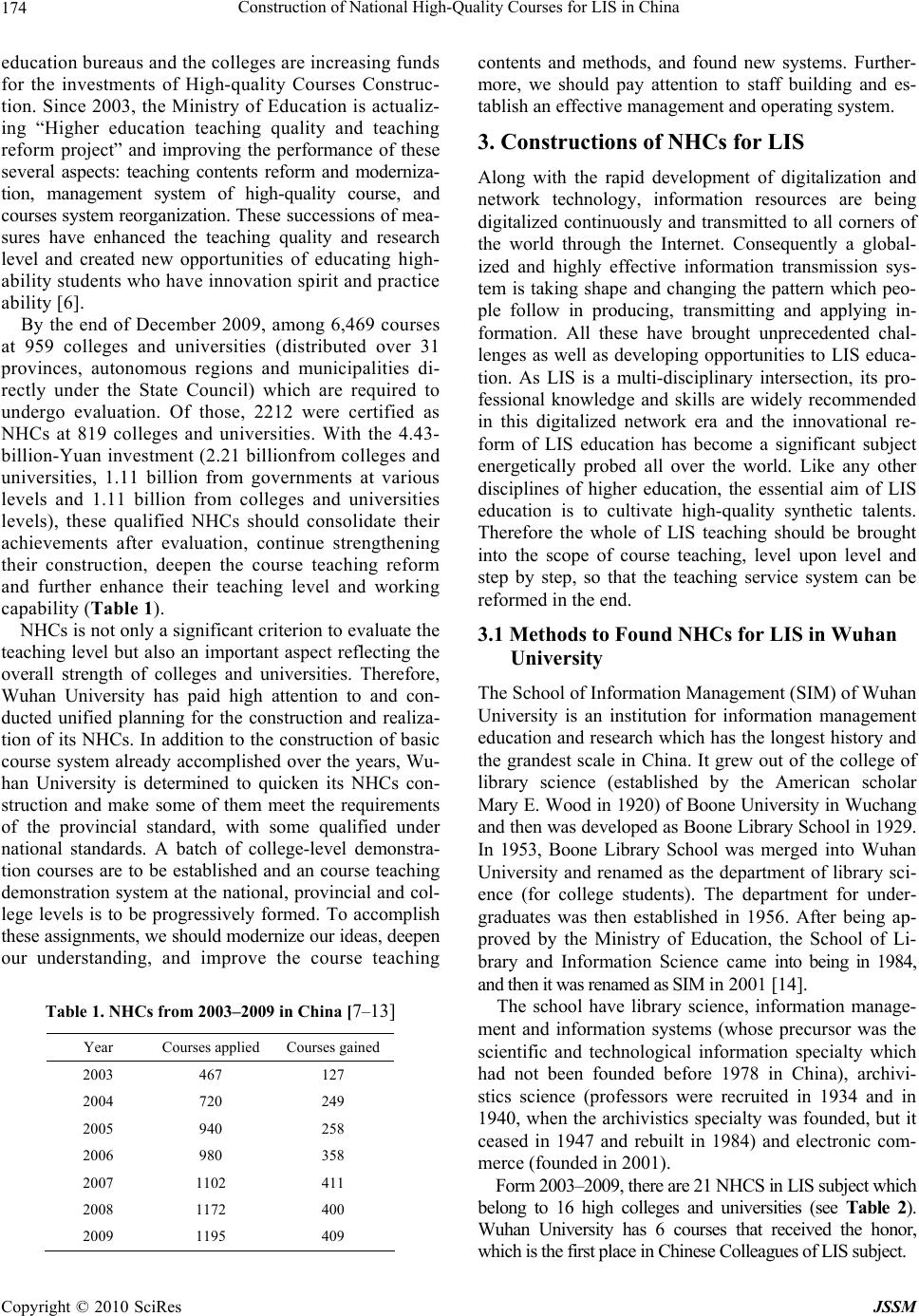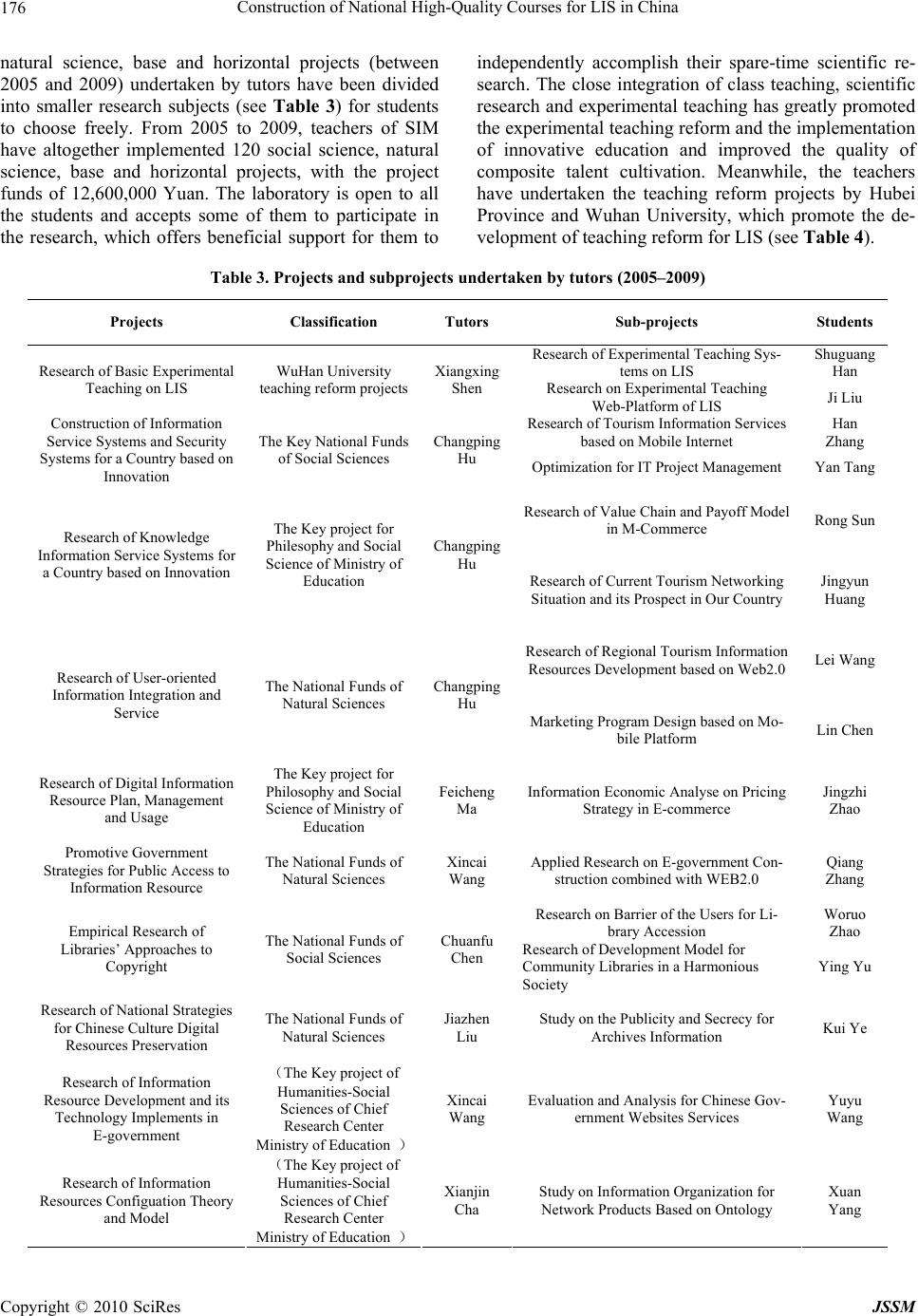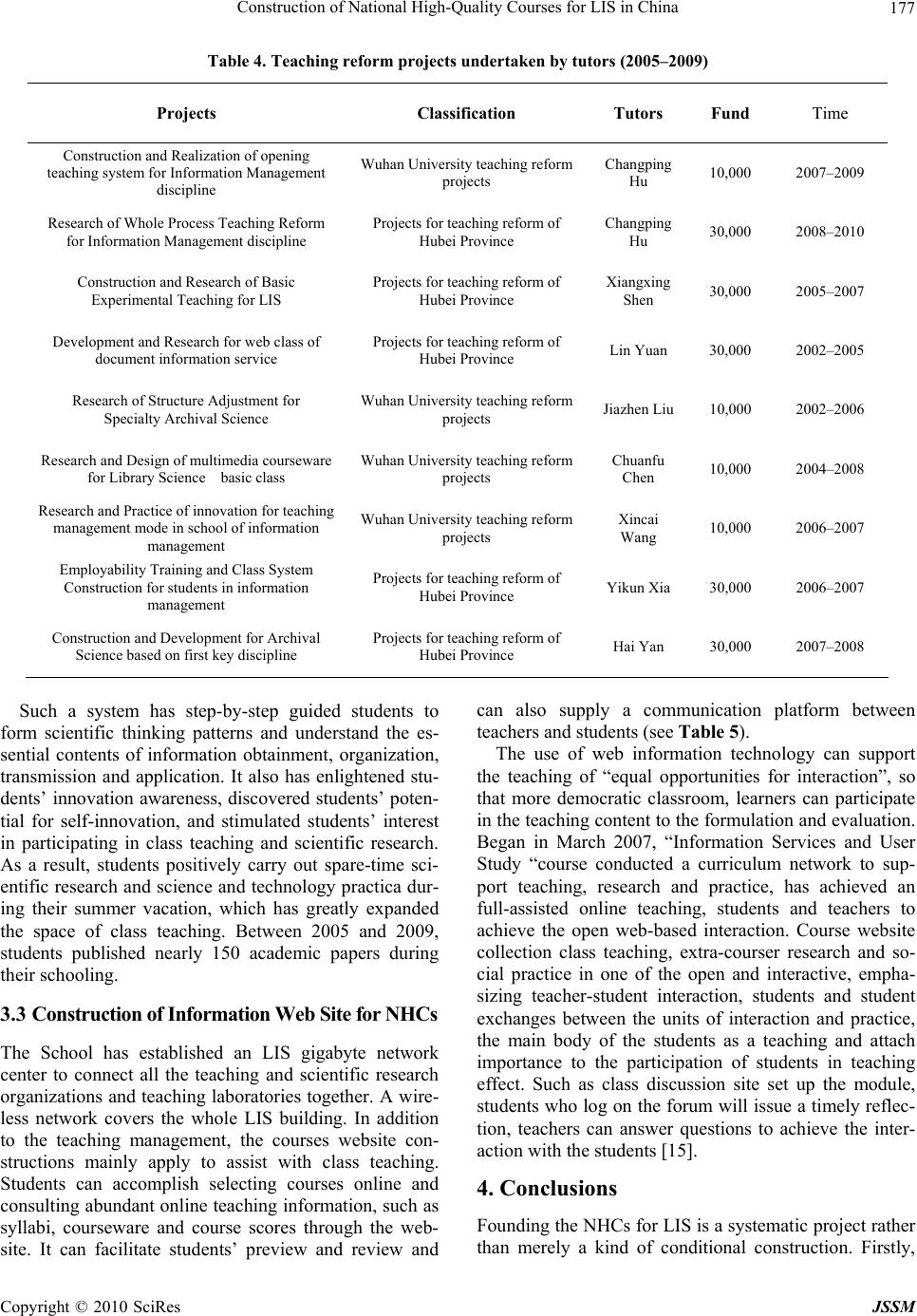Paper Menu >>
Journal Menu >>
 J. Service Science & Management, 2010, 3: 173-179 doi:10.4236/jssm.2010.31022 Published Online March 2010 (http://www.SciRP.org/journal/jssm) Copyright © 2010 SciRes JSSM Construction of National High-Quality Courses for LIS in China Changping Hu, Xueqin Zhao School of Information Management, Wuhan University, Wuhan, China. Email: zxqwhu@yahoo.com.cn Received November 11th, 2009; revised December 26th, 2009; accepted January 28th, 2010. ABSTRACT The paper first introduces the background of Martin Trow’s theory of how to develop mass higher education and then brings up the necessity of Chinese course teaching reform. It introduces the current situation of the construction of the National High-quality Courses (NHCs) in China. And taking the practice of Wuhan University’s library and informa- tion science (LIS) course teaching as an example, the paper also discusses the implementation of this project, focusing on two aspects: a new system of LIS course teaching and network platform construction. The paper concludes by rec- ommending that, for successful LIS NHCs, it is necessary to transform our educational ideology, strengthen our inno- vation, and set up a more beneficial teaching environment for innovation cultivation. Keywords: Mass Higher Educatio n, Course Teaching, National High-Quality Courses, Creative Capability 1. Introduction Based on his research on the development of higher education in America, the well-known American educa- tional sociologist Martin Trow argued that: higher educa- tion systems that enrolled up to 15 percent of the col- lege-age population were best described as elite systems; systems that enrolled between 15 and 40 percent of the age group were mass systems; and those that enrolled more than 40 percent were universal systems [1]. This theory has drawn widespread attention all over th e world, and many countries have attempted accelerating the de- velopment of higher education and stepping into the mass phase as soon as possible. Alongside educational change run concern with and the study of innovation . Rogers (199 5) has no ted that “no other field of behavior science research represents more effort by more scholars in more disciplines in more na- tions” [2]. In an article discussing the work of UNESCO in supporting the development of library schools, Keresz- tesi (1982) was especially concerned with the prevalence of Western influence on the LIS curriculum [3]. An arti- cle by Ballard (1980), a prof essor at North Carolina Cen- tral University School of Library Science, felt that a core curriculum for library science should be developed and adopted by developing countries which would include courses that respond to the particular conditions of these low-income countries and not be carbon copies of curric- ula of developed countries [4]. By 2007, when the gross enrollment ratio reached 23%, Chinese higher education stepped into mass edu- cation phase [5]. As a country whose development was relatively late and was impelled by external factors, China is exploring its own way of developing higher education. Thus we don’t necessarily have to judge the massification course of Chinese higher education strict- ly according to the traditional criterion (15%). Although many aspects of Chinese higher education (e.g. gross enrollment ratio, educational modal diversity, admission and management, curriculum organization, etc.) have shown some characteristics of massification, its devel- opment follows a radical path and lacks sufficient re- source preparation, which makes course construction, can not meet the mass higher education standard badly. In recent years, the Ministry of Education has succes- sively constructed the NHCs from 2003 to 2010 in the whole country to implement the high er education quality standard. 2. Review of NHCs Construction in China The development of National High-quality Courses Construction is using following formats: unprompted school construction, autonomous regions and munici- palities recommendation, the Ministry of Education evaluation, honorary title conferring, and finally con- struction fees assistance. Since China’s reform and open, especially in recent years, state and municipal  Construction of National High-Quality Courses for LIS in China Copyright © 2010 SciRes JSSM 174 education bureaus and the colleges are increasing funds for the investments of High-quality Courses Construc- tion. Since 2003, the Ministry of Education is actualiz- ing “Higher education teaching quality and teaching reform project” and improving the performance of these several aspects: teaching contents reform and moderniza- tion, management system of high-quality course, and courses system reorganization. These successions of mea- sures have enhanced the teaching quality and research level and created new opportunities of educating high- ability students who have innovation spirit and practice ability [6]. By the end of December 2009, among 6,469 courses at 959 colleges and universities (distributed over 31 provinces, autonomous regions and municipalities di- rectly under the State Council) which are required to undergo evaluation. Of those, 2212 were certified as NHCs at 819 colleges and universities. With the 4.43- billion-Yuan investment (2.21 billionfrom colleges and universities, 1.11 billion from governments at various levels and 1.11 billion from colleges and universities levels), these qualified NHCs should consolidate their achievements after evaluation, continue strengthening their construction, deepen the course teaching reform and further enhance their teaching level and working capability (Table 1). NHCs is not only a significant criterion to evalu ate the teaching level but also an important aspect reflecting the overall strength of colleges and universities. Therefore, Wuhan University has paid high attention to and con- ducted unified planning for the construction and realiza- tion of its NHCs. In addition to the construction of basic course system already accomplished over the years, Wu- han University is determined to quicken its NHCs con- struction and make some of them meet the requirements of the provincial standard, with some qualified under national standards. A batch of college-level demonstra- tion courses are to be established and an course teaching demonstration system at the national, provincial and col- lege levels is to be progressively formed. To accomplish these assignments, we should modernize our ideas, deepen our understanding, and improve the course teaching Table 1. NHCs from 2003–2009 in China [7–13] Year Courses applied Courses gained 2003 467 127 2004 720 249 2005 940 258 2006 980 358 2007 1102 411 2008 1172 400 2009 1195 409 contents and methods, and found new systems. Further- more, we should pay attention to staff building and es- tablish an effective management and operating system. 3. Constructions of NHCs for LIS Along with the rapid development of digitalization and network technology, information resources are being digitalized continuously and transmitted to all corners of the world through the Internet. Consequently a global- ized and highly effective information transmission sys- tem is taking shape and changing the pattern which peo- ple follow in producing, transmitting and applying in- formation. All these have brought unprecedented chal- lenges as well as developing opportunities to LIS educa- tion. As LIS is a multi-disciplinary intersection, its pro- fessional knowledge and skills are widely recommended in this digitalized network era and the innovational re- form of LIS education has become a significant subject energetically probed all over the world. Like any other disciplines of higher education, the essential aim of LIS education is to cultivate high-quality synthetic talents. Therefore the whole of LIS teaching should be brought into the scope of course teaching, level upon level and step by step, so that the teaching service system can be reformed in the end. 3.1 Methods to Found NHCs for LIS in Wuhan University The School of Information Management (SIM) of Wuhan University is an institution for information management education and research which h as the longest history and the grandest scale in China. It grew out of the college of library science (established by the American scholar Mary E. Wood in 1920) of Boone University in Wuchang and then was developed as Boone Library School in 1929. In 1953, Boone Library School was merged into Wuhan University and renamed as the department of library sci- ence (for college students). The department for under- graduates was then established in 1956. After being ap- proved by the Ministry of Education, the School of Li- brary and Information Science came into being in 1984, and then it was renamed as SIM in 2001 [14]. The school have library science, information manage- ment and information systems (whose precursor was the scientific and technological information specialty which had not been founded before 1978 in China), archivi- stics science (professors were recruited in 1934 and in 1940, when the archivistics specialty was founded, but it ceased in 1947 and rebuilt in 1984) and electronic com- merce (founded in 2001). Form 2003–2009, there are 21 NHCS in LIS subject which belong to 16 high colleges and universities (see Table 2). Wuhan University has 6 courses that received the honor, which is the firs t place in Chinese Colleagues of LIS subject.  Construction of National High-Quality Courses for LIS in China Copyright © 2010 SciRes JSSM 175 Table 2. NHCs of LIS subject (2003–2009) Subject NHCs Colleges Introduction to Bibliography Wuhan University Foundations of Information Management Wuhan University Electronic File Management Wuhan University Information Service and User Study Wuhan University Information Metrology Wuhan University Information Re so u rce Construction Wuhan University Introduction to Library Science Peking University Introduction to Archival Scienc e Renmin University of China Information Management Science Hefei University of Technology Computer Network National university of Defense Technology Database system and Application Jiangxi University of Finance and Economics Management Information System Xiamen University of Technology Information Systems Analysis an d D es ig n Liaoning University Introduction to Decision Support System Donghua University Management Information Systems Analysis and Design Huazhong University of Science and Technology Documentations Heilongjiang University Information Retrieval and Utilization Shandong University of Technology Information Re so u rce Sharing Sun Yat-sen University Science of Archives Management Guangxi University for N ationalities Archival Science Shanghai University LIS Document Retrieval Central South University 3.2 Course Teaching Reform Based on Core Course Integration The core courses of Library science, Archives science and Information management science will be integrated with the development trend of the subject integration. In our school, we reform in 5 NHCs which named as Intro- duction to Bibliography, Foundations of Information Management, Electronic File Management, Information Service and User Stud y, Information Resource Con struc- tion and Information Metrology in order to realize the core course reform of LIS. In the open environment, we try to construct the new teaching system of core course that can adapt to the new requirements. The teaching reform has laid equal stress on both classical and modern, essential and frontier theories. It has been updated closely by following the disciplin e’s development to cre- ate a bigger space and to get a raise in synthesis, design, and research so that course teaching, scientific research, projects and social application practice can be closely integrated, furthering reciprocity and establishing a skillful, personalized, diversified and modernized course teaching system. The course reform should also fully be brought into playing the supporting role of the two national key disci- plines of library science and information science as well as the following organizations: the research center of information resources; the cultivation center for senior publication talents of the Press and Publication Admini- stration unit; the senior research center of intellectual property rights; the research center for science evaluation in China; the Chinese e-commerce research and devel- opment center; the Institute of Library and Information Science; the Institute of Publication, the Institute of Digital Libraries; the Institute of Study on Complete Collection in Four Treasuries; and the Institute of Elec- tronic Document and Go vernment In formatio n. Scientific research methods and achievements and scientific think- ing patterns should be organically integrated into ex- perimental teaching, and parts of the social science,  Construction of National High-Quality Courses for LIS in China Copyright © 2010 SciRes JSSM 176 natural science, base and horizontal projects (between 2005 and 2009) undertaken by tutors have been divided into smaller research subjects (see Table 3) for students to choose freely. From 2005 to 2009, teachers of SIM have altogether implemented 120 social science, natural science, base and horizontal projects, with the project funds of 12,600,000 Yuan. The laboratory is open to all the students and accepts some of them to participate in the research, which offers beneficial support for them to independently accomplish their spare-time scientific re- search. The close integration of class teaching, scientific research and experimental teaching has greatly promoted the experimental teaching reform and the implementation of innovative education and improved the quality of composite talent cultivation. Meanwhile, the teachers have undertaken the teaching reform projects by Hubei Province and Wuhan University, which promote the de- velopment of teaching reform for LIS (see Table 4). Table 3. Projects and subprojects undertaken by tutors (2005–2009) Projects Classification Tutors Sub-projects Students Research of Experimental Teaching Sys- tems on LIS Shuguang Han Research of Basic Experimental Teaching on LIS WuHan University teaching reform projectsXiangxing Shen Resear c h o n E xp e rimental Teaching Web-Platform of LIS Ji Liu Research of Tourism Informa tion Se rvices based on Mobile Internet Han Zhang Construction of Information Service Systems and Security Systems for a Country based on Innovation The Key National Funds of Social Sciences Changping Hu Optimization for IT Project Management Yan Tang Research of Value Chain and Payoff Model in M-Commerce Rong Sun Research of Knowledge Information Service Systems for a Country based on Innovation The Key project for Philesophy and Social Science of Ministry of Education Changping Hu Research of Current Touri sm Networking Situation and its Prospect in Our Country Jingyun Huang Research of Regional Tourism Information Resources Development based on W e b2 .0 Lei Wang Research of User-oriented Information Integration and Service The National Funds of Natural Sciences Changping Hu Marketing Program Design based on Mo- bile Platform Lin Chen Research of Digital Information Resource Plan, Management and Usage The Key project for Philosophy and Social Science of Ministry of Education Feicheng Ma Information Economic Analyse on Pricing Strategy in E-commerce Jingzhi Zhao Promotive Government Strategies for Public Access to Information Reso urce The National Funds of Natural Sciences Xincai Wang Applied Research on E-governme nt Con- struction combined with WEB2.0 Qiang Zhang Research on Barrier of the Users for Li- brary Accession Woruo Zhao Empirical Research of Libraries’ Approaches to Copyright The National Funds of Social Sciences Chuanfu Chen Research of Development Model for Community Libraries in a Harmonious Society Ying Yu Research of National Strategies for Chinese Culture Dig i t a l Resources Preservation The National Funds of Natural Sciences Jiazhen Liu Study on the Publicity and Secrecy for Archives Information Kui Ye Research of Information Resource Development and its Technology Implements in E-government (The Key project of Humanities-Social Sciences of Chief Research Center Ministry of Education ) Xincai Wang Evaluation and Analysis for Chinese Gov- ernment Websites Services Yuyu Wang Research of Information Resources Configuatio n Theory and Model (The Key project of Humanities-Social Sciences of Chief Research Center Ministry of Education ) Xianjin Cha Study on Information Organization for Network Products Based on Ontology Xuan Yang  Construction of National High-Quality Courses for LIS in China Copyright © 2010 SciRes JSSM 177 Table 4. Teaching reform projects undertaken by tutors (2005–2009) Projects Classification Tutors Fund Time Construction and Realization of o pening teaching system for Information Management discipline Wuhan University teaching reform projects Changping Hu 10,000 2007–2009 Research of Whole Process Teaching Reform for Inform ati on Management discipline Projects for teaching reform of Hubei Province Changping Hu 30,000 2008–2010 Construction and Research of Basic Experimental Teaching for LIS Projects for teaching reform of Hubei Province Xiangxing Shen 30,000 2005–2007 Development and Research for web class of document information service Projects for teaching reform of Hubei Province Lin Yuan 30,000 2002–2005 Research of Structure Adjustme nt for Specialty Archival Science Wuhan University teaching reform projects Jiazhen Liu 10,000 2002–2006 Research and Design of multimedia courseware for Library Science basic class Wuhan University teaching reform projects Chuanfu Chen 10,000 2004–2008 Research and Practice of innovation for tea c hi n g management mode in school of information management Wuhan University teaching reform projects Xincai Wang 10,000 2006–2007 Employability Training and Class System Construction for students in information management Projects for teaching reform of Hubei Province Yikun Xia 30,000 2006–2007 Construction and Development for Ar chiv al Science based on first key discipline Projects for teaching reform of Hubei Province Hai Yan 30,000 2007–2008 Such a system has step-by-step guided students to form scientific thinking patterns and understand the es- sential contents of information obtainment, organization, transmission and application. It also has enlightened stu- dents’ innovation awareness, discovered students’ poten- tial for self-innovation, and stimulated students’ interest in participating in class teaching and scientific research. As a result, students positively carry out spare-time sci- entific research and science and technology practica dur- ing their summer vacation, which has greatly expanded the space of class teaching. Between 2005 and 2009, students published nearly 150 academic papers during their schooling. 3.3 Construction of Information Web Site for NHCs The School has established an LIS gigabyte network center to connect all the teaching and scientific research organizations and teaching laboratories together. A wire- less network covers the whole LIS building. In addition to the teaching management, the courses website con- structions mainly apply to assist with class teaching. Students can accomplish selecting courses online and consulting abundant online teaching information, such as syllabi, courseware and course scores through the web- site. It can facilitate students’ preview and review and can also supply a communication platform between teachers and students (see Table 5). The use of web information technology can support the teaching of “equal opportunities for interaction”, so that more democratic classroom, learners can participate in the teaching content to the formulation and evaluation. Began in March 2007, “Information Services and User Study “course conducted a curriculum network to sup- port teaching, research and practice, has achieved an full-assisted online teaching, students and teachers to achieve the open web-based interaction. Course website collection class teaching, extra-courser research and so- cial practice in one of the open and interactive, empha- sizing teacher-student interaction, students and student exchanges between the units of interaction and practice, the main body of the students as a teaching and attach importance to the participation of students in teaching effect. Such as class discussion site set up the module, students who log on the forum will issue a timely reflec- tion, teachers can answer questions to achieve the inter- action with the students [15]. 4. Conclusions Founding the NHCs for LIS is a systematic project rather than merely a kind of conditional construction. Firstly,  Construction of National High-Quality Courses for LIS in China Copyright © 2010 SciRes JSSM 178 Table 5. Web site resources of LIS NHCs Columns Introductions to each column Teacher A brief introduction to the course teachers. Brief introduction A brief introduction to the course Credit. Teaching syllabi Syllabi for the courses. Textbook Textbooks for the courses. Synchronous teaching Power Point of all the courses teachers. Research Project Projects that undertaken by teachers. Academic Result Teachers teaching papers published statis- tical tables. Students’ papers Papers that students published after the class. Practices out of class A brief introduction to the practices out of class. Relative practice results and excel- lent. Practice reports are also available Teaching news News for course teaching. Examinations and tests General methods of tests for tests courses. Teaching video Teaching video for the cou r se . Teaching references List bibliographies of all the excellence courses and links of some relative websites for learning. Provi d e c ommonly- used software downloads for students. Teaching blog Provide students a platform to discuss together and thus promote their enthusiasm for study. we have the obligation of transforming our modes of thinking, further deepen course teaching reform, and promote the transition of education towards the qual- ity-oriented type so as to create a more beneficial course teaching environment for cultivating innovation ability. Second, besides the hardware construction, we should pay more attention to the software to strive to construct the course teaching center as a high-level course teaching base with real and demonstrative functions, cultivate innovative cross-century talents and make a contribution to the improvement of LIS higher education quality. The American education system lays more emphasis on freedom, dialectical thinking, and student-centered pedagogy, while China’s education system lays more stress on well-knit, highly disciplined, and top-down pedagogy. Since these two kinds of systems can’t com- pletely be mixed together, what we could do is to pro- foundly understand the American education system and enhance our course teaching reform to improve LIS higher education quality an d thus cultivate more creative talents for China. 5. Acknowledgment The paper is the research result of the projects for teach- ing reform of Hubei Province “Research of Whole Proc- ess Teaching Reform for Information Management disci- pline” (No. 2008004). REFERENCES [1] T. Martin, “The expansion and transformation of higher edu- cation,” International Review of Education, Vol. 1, pp. 61– 63, 1972. [2] E. D. Rogers, “Diffusion of Innovations, 4th ed.,” The Free Press, New York, 1995. [3] M. Keresztesi, “UNESCO’s work in the field of library education and training: An overview and assessment,” International Information and Library Review, Vol. 14, pp. 349–361, 1982. [4] R. M. Ballard, “Library education and library problems in developing nations,” International Information and Li- brary Review, Vol. 12, pp. 65–70, 1980. [5] The Ministry of Education of PRC, “The 2007 education development statistical bulletin,” Accessed May 3, 2009, Available at: http://www.moe.gov.cn/edoas/website18/ 54/info1209972965475254.htm. [6] The Ministry of Education of PRC, “The notice for the higher education teaching quality and teaching reform project of national excellence courses,” Accessed May 7, 2009, Available at http://www.moe.edu.cn/edoas/web- site18/level3.jsp?tablename=1193&infoid=13676. [7] The Ministry of Education of PRC, “The notice for the national excellence course in 2003,” Accessed October 8, 2009, Available at: http:// www.jpkcnet.com/new/zheng- ce/Announces_detail.asp?Announces_ID=33. [8] The Ministry of Education of PRC, “The notice for the national excellence courses in 2004,” Accessed October 9, 2009, Available at: http://www.jpkcnet.com/new/zheng- ce/Announces_detail.asp?Announces_ID=43. [9] The Ministry of Education of PRC, “The notice for the national excellence courses in 2005,” Accessed October 11, 2009, Available at: http://www.jpkcnet.com/new/zh- engce/Announces_detail.asp?Announces_ID=63, [10] The Ministry of Education of PRC, “The notice for the national excellence courses in 2006,” Accessed October 12, 2009, Available at: http://www.jpkcnet.com/new/zhe- ngce/Announces_detail.asp?Announces_ID=84. [11] The Ministry of Education of PRC, “The notice for the national excellence courses in 2007,” Accessed October 13, 2009, nounces_detail.asp?Announces_ID=115. [12] The Ministry of Education of PRC, “The notice for the national excellence courses in 2008,” Accessed October 14, 2009, Available at: http://www.jpkcnet.com/new/zhe- ngce/Announces_detail.asp?Announces_ID=142. [13] The Ministry of Education of PRC, “The notice for the national excellence courses in 2009,” Accessed October 17, 2009, http://www.jpkcnet.com/new/zhengce/Announces_ detail.asp?Announces_ID=158. [14] Z. Zheng and X. X. Shen “Construction and discussion of LIS expe rimental teachin g center in China,” Jou rnal of Edu- cation for Library an d Informati on Science, Vol. 4, pp. 321– 326, 2007. [15] C. P. Hu and X. Q. Zhao, “Construction of web-based  Construction of National High-Quality Courses for LIS in China Copyright © 2010 SciRes JSSM 179 learning platform for information management subject— case study on ‘information service & user’ course web- site,” Proceedings – International Conference on Com- puter Science and Software Engi neering, CSSE’08, Vol. 5, pp. 760–763, 2008. |

